Terlincthun British Cemetery
Roll of Honour
World War One
A - K
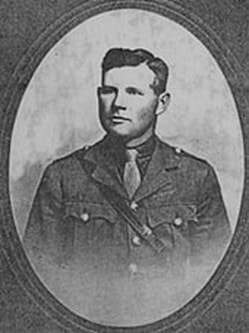
Lieutenant
H. Banks M. C.
102nd Canadian Infantry
17th October 1918.
Plot V. F. 36.
H. Banks M. C.
102nd Canadian Infantry
17th October 1918.
Plot V. F. 36.
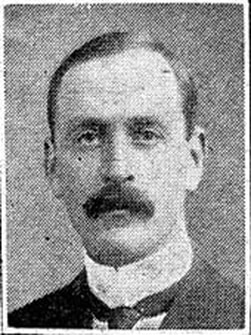
Colonel
Frank Ridley Farrer Boileau (Mentioned in Despatches)
Royal Engineers, attd. as G.S.O.1 to 3rd Div. General Staff
28th August 1914, aged 46.
Plot 16. A.B. 1.
Son of Col. F. W. Boileau, C.B., and Letitia Boileau (nee Bradford); husband of Mary A. Boileau, of Windout Hill House, Exeter.
Frank Ridley Farrer Boileau (Mentioned in Despatches)
Royal Engineers, attd. as G.S.O.1 to 3rd Div. General Staff
28th August 1914, aged 46.
Plot 16. A.B. 1.
Son of Col. F. W. Boileau, C.B., and Letitia Boileau (nee Bradford); husband of Mary A. Boileau, of Windout Hill House, Exeter.
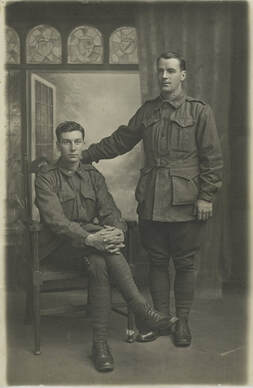
33500 Gunner
Cornelius Albert Boundy (Standing)
4th Brigade, Australian Field Artillery
23rd February 1919, aged 28.
Plot XIII. E. 42.
Inscription "Ever Remembered By His Loving Parents"
Click on image to enlarge
Son of Cornelious and Sarah Ann Boundy, of 23, Frost St., Brompton Park, South Australia.
Studio portrait of brothers 5523 Sapper (Spr) Arthur William Boundy, 13th Field Company Engineers (left), and 33500 Gunner (Gnr) Cornelius Albert Boundy, 4th Field Artillery Brigade (right). Spr Arthur Boundy, a farm hand from Brompton Park, South Australia, enlisted on 9 August 1915 and embarked from Sydney on board HMAT Berrima (A35) on 17 December 1915. He served in France and died of disease on 10 November 1918 aged 23. He is buried in St. Sever Cemetery Extension in Rouen. Gnr Cornelius Boundy, a labourer from Brompton Park, SA, enlisted on 1 October 1915 and embarked from Victoria aboard HMAT Shropshire (A9) on 11 May 1917. He too served in France and he too died of disease on 23 February 1919 aged 28.
Cornelius Albert Boundy (Standing)
4th Brigade, Australian Field Artillery
23rd February 1919, aged 28.
Plot XIII. E. 42.
Inscription "Ever Remembered By His Loving Parents"
Click on image to enlarge
Son of Cornelious and Sarah Ann Boundy, of 23, Frost St., Brompton Park, South Australia.
Studio portrait of brothers 5523 Sapper (Spr) Arthur William Boundy, 13th Field Company Engineers (left), and 33500 Gunner (Gnr) Cornelius Albert Boundy, 4th Field Artillery Brigade (right). Spr Arthur Boundy, a farm hand from Brompton Park, South Australia, enlisted on 9 August 1915 and embarked from Sydney on board HMAT Berrima (A35) on 17 December 1915. He served in France and died of disease on 10 November 1918 aged 23. He is buried in St. Sever Cemetery Extension in Rouen. Gnr Cornelius Boundy, a labourer from Brompton Park, SA, enlisted on 1 October 1915 and embarked from Victoria aboard HMAT Shropshire (A9) on 11 May 1917. He too served in France and he too died of disease on 23 February 1919 aged 28.
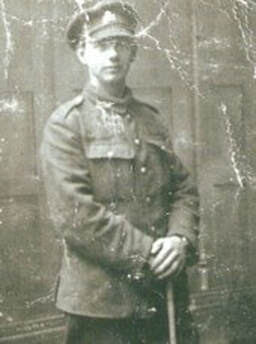
203205 Corporal
Victor Albert Brown
1st/5th Bn. South Staffordshire Regiment
16th October 1918, aged 21
Plot V. F. 4.
Son of Joseph Rose Brown and Elizabeth Brown, of 77, North Rd., Wolverhampton.
His brother Pte Joseph George Brown 36182 was also KIA on April 10th 1918, aged 19, whilst serving in the 4th South Staffs, remembered on the Ploegsteert Memorial Panel 6.
Picture courtesy of Dave Shaw
Victor Albert Brown
1st/5th Bn. South Staffordshire Regiment
16th October 1918, aged 21
Plot V. F. 4.
Son of Joseph Rose Brown and Elizabeth Brown, of 77, North Rd., Wolverhampton.
His brother Pte Joseph George Brown 36182 was also KIA on April 10th 1918, aged 19, whilst serving in the 4th South Staffs, remembered on the Ploegsteert Memorial Panel 6.
Picture courtesy of Dave Shaw
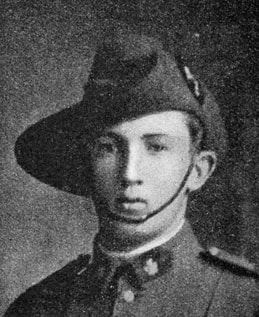
367 Corporal
Charles Vince Carr
13th Bn. Australian Infantry, A. I. F.
12th August 1918, aged 25.
Plot II. C. 5.
Son of Albert and Eliza Louisa Carr, of Smith St., Parramatta, New South Wales. Native of Bathurst, New South Wales.
Studio portrait of 367 Private (later Corporal) Charles Vince Carr 13th Battalion, of Parramatta, NSW. A butcher prior to initially enlisting and later a salesman prior to re-enlisting. Initially, he embarked from Melbourne aboard the HMAT Ulysses (A38) on 22 December 1914. He was invalided home in September 1915 and after re-enlisting, he embarked from Sydney aboard the HMAT Clan McGillivray (A46) on 3 May 1916. Cpl Carr was wounded in action on 9 August 1918 and died of wounds on 12 August 1918 in France, aged 25.
Charles Vince Carr
13th Bn. Australian Infantry, A. I. F.
12th August 1918, aged 25.
Plot II. C. 5.
Son of Albert and Eliza Louisa Carr, of Smith St., Parramatta, New South Wales. Native of Bathurst, New South Wales.
Studio portrait of 367 Private (later Corporal) Charles Vince Carr 13th Battalion, of Parramatta, NSW. A butcher prior to initially enlisting and later a salesman prior to re-enlisting. Initially, he embarked from Melbourne aboard the HMAT Ulysses (A38) on 22 December 1914. He was invalided home in September 1915 and after re-enlisting, he embarked from Sydney aboard the HMAT Clan McGillivray (A46) on 3 May 1916. Cpl Carr was wounded in action on 9 August 1918 and died of wounds on 12 August 1918 in France, aged 25.
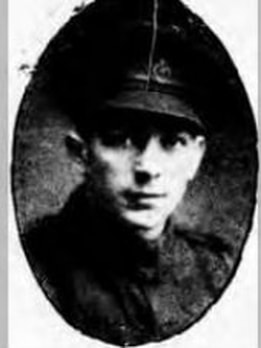
481113 Lance Serjeant
Walter John William Carter
55th General Hospital, Royal Army Medical Corps
3rd November 1918, aged 22.
Plot X. A. 18.
Son of Mrs. Louisa Carter, of 57, Beche Rd., Abbey Estate, Cambridge.
Walter John William Carter
55th General Hospital, Royal Army Medical Corps
3rd November 1918, aged 22.
Plot X. A. 18.
Son of Mrs. Louisa Carter, of 57, Beche Rd., Abbey Estate, Cambridge.
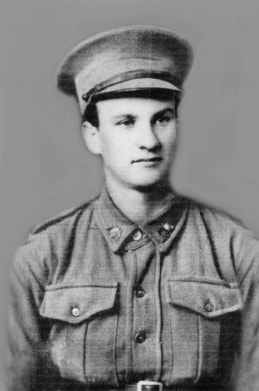
2333 Private
Oliver Abe Compton
3rd Bn. Australian Infantry, A. I. F.
31st July 1918, aged 23.
Plot I. F. 41.
Inscription "He Heard The Call"
Click on image to enlarge
Son of Abraham and the late Susannah Compton, of Junction St., Junee, New South Wales. Native of Goulburn.
Studio portrait of 2333 Private (Pte) Oliver Abe Compton, 3rd Battalion, of Junee Junction, NSW. A plumber prior to enlisting in November 1914, Pte Compton embarked from Sydney with the 2nd Reinforcements aboard HMAT Seang Bee (A48) on 11 February 1915. His battalion arrived at Gallipoli on 25 April 1915 and Pte Compton was wounded in action on 30 April. He arrived in France for service on the Western Front in March 1916 and was wounded in action a second time on 7 November 1916. Pte Compton was wounded in action a third time at Merris, France, on 24 June 1918 and died of his wounds on 31 July 1918. He was 23 years of age.
Oliver Abe Compton
3rd Bn. Australian Infantry, A. I. F.
31st July 1918, aged 23.
Plot I. F. 41.
Inscription "He Heard The Call"
Click on image to enlarge
Son of Abraham and the late Susannah Compton, of Junction St., Junee, New South Wales. Native of Goulburn.
Studio portrait of 2333 Private (Pte) Oliver Abe Compton, 3rd Battalion, of Junee Junction, NSW. A plumber prior to enlisting in November 1914, Pte Compton embarked from Sydney with the 2nd Reinforcements aboard HMAT Seang Bee (A48) on 11 February 1915. His battalion arrived at Gallipoli on 25 April 1915 and Pte Compton was wounded in action on 30 April. He arrived in France for service on the Western Front in March 1916 and was wounded in action a second time on 7 November 1916. Pte Compton was wounded in action a third time at Merris, France, on 24 June 1918 and died of his wounds on 31 July 1918. He was 23 years of age.
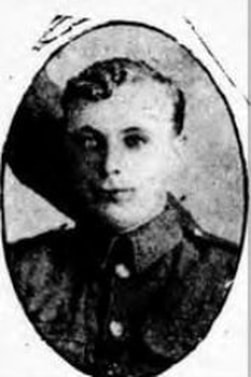
37411 Gunner
Lawrence Cooper
120th Heavy Battery, Royal Garrison Artillery
8th November 1918, aged 24.
Plot X. C. 22.
Son of William and Sarah Cooper, of Station Rd., Longstowe, Cambs.
Lawrence Cooper
120th Heavy Battery, Royal Garrison Artillery
8th November 1918, aged 24.
Plot X. C. 22.
Son of William and Sarah Cooper, of Station Rd., Longstowe, Cambs.
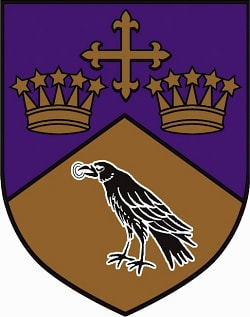
17698 Driver
Eric Claudius Davison Crigan
British Red Cross Society
30th January 1919, aged 19.
Plot XIII. B. 20.
Son of Dorothy Crigan, of West Kensington, London.
His headstone bears the inscription "A Greater Love Hath No Man Than To Lay Down His Life For His Friends"
The information below supplied by 'The Ellesmerian Club', the alumni organisation for Ellesmere College where Eric was a pupil.
Eric Claudius Davison Crigan
British Red Cross Society
30th January 1919, aged 19.
Plot XIII. B. 20.
Son of Dorothy Crigan, of West Kensington, London.
His headstone bears the inscription "A Greater Love Hath No Man Than To Lay Down His Life For His Friends"
The information below supplied by 'The Ellesmerian Club', the alumni organisation for Ellesmere College where Eric was a pupil.
Eric Claudius Davison Crigan, born on 11th October 1899, was eleven when he was admitted to Ellesmere College, north Shropshire after a time at Sherborne School. His family moved around England quite extensively during their lives. His parents, Charles Claudius and Dorothy Crigan came from Yorkshire and Gloucestershire respectively and were married in London by Special Licence. Eric was born in Bournemouth, Hampshire and his elder sister Dorothy in Suffolk in 1896.
During his stay at Ellesmere, from September 1910 to December 1911, he resided in the ‘Heywood’ dormitory. Eric was one of twenty-eight new boys that term and, without doubt, he would have befriended Charles Gurley, William stringer and Howard Ramsell – they were all in the same dorm. In fact, five boys were admitted to the ‘Heywood’ that term and four of them would die either on active service or of wounds / illness contracted on service during the Great War. On Sports Day 1911, Eric demonstrated his running ability by taking 2nd place in the Under 12 category 100, 220 and 440 Yards Flat Races. He was also a good singer and took part in the School Concert of 1912 performing in a duet and part song. All that is known about the academic side of his college life is that he was placed in Form Lower II under the tutelage of Mr. K. J. Miller.
Eric left Ellesmere at the end of the winter term 1911. A few weeks later, on 17th January 1912 he was admitted to HMS Conway, a training ship that was, at the time, officially recognised as a public school. He remained a cadet there until June 1913 when he went on to Weymouth College, Dorset where his family lived
On 11th October 1914, having undergone a medical examination at Poole, Eric was deemed fit to join the 7th(Reserve) Cadet Battalion, the 9th Lancers as ‘Boy’ Crigan, Service 8570. His education continued at Tidworth Army School, where he gained a Third and, later, a Second Class Certificate of Education. He was 5’ 4” tall (1.60m) and weight 109 pounds (50 kg). His complexion was described as ‘sallow’ and it soon transpired that he was not that physically fit. On 8th June 1915, a Medical Board Report stated that he was medically unfit for war service due to valvular disease and he was discharged with a £20 gratuity. He was placed in the 7thReserve Cavalry and was awarded a Silver War Badge to wear so that everyone would realise he had ‘done his bit’.
On 17th October 1917, Eric was called up and presented himself at the R. F. C. Recruits Depot. He was a student and was living with his mother at 16, Marion Road, Southsea. After another medical examination, his enlistment was approved and he was appointed to the Royal Flying Corps as 3rd Class Air Mechanic. The few records that have survived show that he was “unfit as Flying Officer in any capacity” and so it seems that the authorities were well aware he did not enjoy the best of health. On 7th October, he was posted to No. 5 Officer Cadet Wing (OCW) at Hastings, Sussex but less than ten days later he was posted to No. 1 OCW. However, his time there was short-lived as, two days before Christmas, he was compulsorily transferred to the Royal West Kent Regiment prior to his being placed on the nominal roll of the 20th (Reserve) Battalion, the London Regiment. Yet again his health issues caught up with him and, on 8th May 1918, he was honourably discharged under the King’s Regulations Para. 392 xvi. As he was no longer “medically fit for war service”. He was suffering from dilation of myocardium with a 40% disablement.
This was not, however, the end of Eric’s involvement in the war for the Commonwealth War Graves Commission tends his grave at Terlincthun War Cemetery. Eric had died of pneumonia on 30th January 1919 whilst an ambulance driver for the British Red Cross. Whilst the primary role of the organisation was to assist the military medical personnel that treated the sick and wounded, their presence was seen in all theatres of war and at all levels from providing ambulance drivers to simple acts such as manning rest rooms at railway stations to provide troops in transit with some basic comforts.
Eric had joined the organisation and had been sent to France on 22nd August, less than three months before the Armistice was signed. Exactly where he served or with which unit is not recorded. After Eric’s death, his mother wrote to W. L. Sumsion, Secretary at Ellesmere, to say that her son had contracted pneumonia “doing continuous night driving as well as day work”. He had not been well and his Commanding Officer said that they had to insist on his leaving his ambulance and go to hospital, much against his will, some three days before his death.
Eric was just nineteen years old when he died. For his military service, he was awarded the Victory Medal and the British War Medal.
During his stay at Ellesmere, from September 1910 to December 1911, he resided in the ‘Heywood’ dormitory. Eric was one of twenty-eight new boys that term and, without doubt, he would have befriended Charles Gurley, William stringer and Howard Ramsell – they were all in the same dorm. In fact, five boys were admitted to the ‘Heywood’ that term and four of them would die either on active service or of wounds / illness contracted on service during the Great War. On Sports Day 1911, Eric demonstrated his running ability by taking 2nd place in the Under 12 category 100, 220 and 440 Yards Flat Races. He was also a good singer and took part in the School Concert of 1912 performing in a duet and part song. All that is known about the academic side of his college life is that he was placed in Form Lower II under the tutelage of Mr. K. J. Miller.
Eric left Ellesmere at the end of the winter term 1911. A few weeks later, on 17th January 1912 he was admitted to HMS Conway, a training ship that was, at the time, officially recognised as a public school. He remained a cadet there until June 1913 when he went on to Weymouth College, Dorset where his family lived
On 11th October 1914, having undergone a medical examination at Poole, Eric was deemed fit to join the 7th(Reserve) Cadet Battalion, the 9th Lancers as ‘Boy’ Crigan, Service 8570. His education continued at Tidworth Army School, where he gained a Third and, later, a Second Class Certificate of Education. He was 5’ 4” tall (1.60m) and weight 109 pounds (50 kg). His complexion was described as ‘sallow’ and it soon transpired that he was not that physically fit. On 8th June 1915, a Medical Board Report stated that he was medically unfit for war service due to valvular disease and he was discharged with a £20 gratuity. He was placed in the 7thReserve Cavalry and was awarded a Silver War Badge to wear so that everyone would realise he had ‘done his bit’.
On 17th October 1917, Eric was called up and presented himself at the R. F. C. Recruits Depot. He was a student and was living with his mother at 16, Marion Road, Southsea. After another medical examination, his enlistment was approved and he was appointed to the Royal Flying Corps as 3rd Class Air Mechanic. The few records that have survived show that he was “unfit as Flying Officer in any capacity” and so it seems that the authorities were well aware he did not enjoy the best of health. On 7th October, he was posted to No. 5 Officer Cadet Wing (OCW) at Hastings, Sussex but less than ten days later he was posted to No. 1 OCW. However, his time there was short-lived as, two days before Christmas, he was compulsorily transferred to the Royal West Kent Regiment prior to his being placed on the nominal roll of the 20th (Reserve) Battalion, the London Regiment. Yet again his health issues caught up with him and, on 8th May 1918, he was honourably discharged under the King’s Regulations Para. 392 xvi. As he was no longer “medically fit for war service”. He was suffering from dilation of myocardium with a 40% disablement.
This was not, however, the end of Eric’s involvement in the war for the Commonwealth War Graves Commission tends his grave at Terlincthun War Cemetery. Eric had died of pneumonia on 30th January 1919 whilst an ambulance driver for the British Red Cross. Whilst the primary role of the organisation was to assist the military medical personnel that treated the sick and wounded, their presence was seen in all theatres of war and at all levels from providing ambulance drivers to simple acts such as manning rest rooms at railway stations to provide troops in transit with some basic comforts.
Eric had joined the organisation and had been sent to France on 22nd August, less than three months before the Armistice was signed. Exactly where he served or with which unit is not recorded. After Eric’s death, his mother wrote to W. L. Sumsion, Secretary at Ellesmere, to say that her son had contracted pneumonia “doing continuous night driving as well as day work”. He had not been well and his Commanding Officer said that they had to insist on his leaving his ambulance and go to hospital, much against his will, some three days before his death.
Eric was just nineteen years old when he died. For his military service, he was awarded the Victory Medal and the British War Medal.
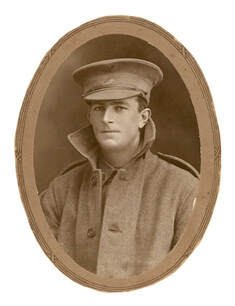
737 Private
Henry Richard Denkel
7th Bn. Australian Infantry, A. I. F.
15th August 1918, aged 21.
Plot II. C. 25.
Click on image to enlarge
Son of Herrman and Hannah Teresa Denkel, of Diapur, Victoria, Australia. Native of Nhill, Victoria, Australia.
Studio portrait of 737 Private (Pte) Henry Richard Denkel, 38th Battalion. A farmer of Diapur via Nhill, Victoria, he embarked with B Company aboard HMAT Runic (A54) in June 1916. Pte Denkel died of wounds on 15 August 1918 in France, aged 21 years.
Henry Richard Denkel
7th Bn. Australian Infantry, A. I. F.
15th August 1918, aged 21.
Plot II. C. 25.
Click on image to enlarge
Son of Herrman and Hannah Teresa Denkel, of Diapur, Victoria, Australia. Native of Nhill, Victoria, Australia.
Studio portrait of 737 Private (Pte) Henry Richard Denkel, 38th Battalion. A farmer of Diapur via Nhill, Victoria, he embarked with B Company aboard HMAT Runic (A54) in June 1916. Pte Denkel died of wounds on 15 August 1918 in France, aged 21 years.
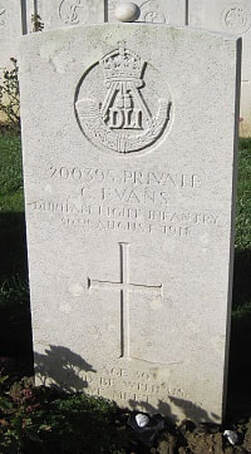
2000395 Private
Charlie Evans
18th (Res.) Bn. Durham Light Infantry
30th August 1918, aged 31.
Plot II. F. 38.
INSCRIPTION. AGE 30 GOD BE WITH US TILL WE MEET AGAIN.
Son of Mary Evans, of 2, Hibernia St., Thornaby-on-Tees; husband of Minnie Evans, of 38, Warwick Rd., Luton.
Remembered by his Great Nieces Helen Moore and Sarah Watts
Charlie Evans
18th (Res.) Bn. Durham Light Infantry
30th August 1918, aged 31.
Plot II. F. 38.
INSCRIPTION. AGE 30 GOD BE WITH US TILL WE MEET AGAIN.
Son of Mary Evans, of 2, Hibernia St., Thornaby-on-Tees; husband of Minnie Evans, of 38, Warwick Rd., Luton.
Remembered by his Great Nieces Helen Moore and Sarah Watts
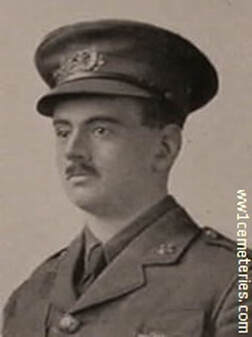
Lieutenant
Wilfrid John Mackenzie Hadfield
2nd Bn. South Lancashire Regiment
10th September 1914, aged 25.
Plot X. AB. 14.
Son of Major General C. A. Hadfield and Florence Elizabeth Hadfield, of 28, Basset Rd., North Kensington, London.
Wilfrid John Mackenzie Hadfield
2nd Bn. South Lancashire Regiment
10th September 1914, aged 25.
Plot X. AB. 14.
Son of Major General C. A. Hadfield and Florence Elizabeth Hadfield, of 28, Basset Rd., North Kensington, London.
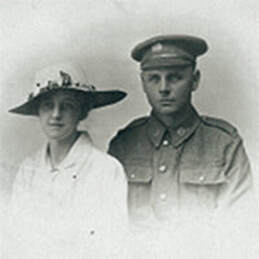
Harold Hawkin
3rd Tunnelling Coy. Canadian Engineers
18th June 1918, aged 32.
Plot I. A. 33.
Son of John Horsley and Anne Hawkin, of York; husband of Millicent Hawkin, of 4, Langdale Rd., Scarborough.
Also commemorated on the St Paul’s Church War Memorial, Holgate and in The King’s Book. His medals are held by the Canadian War Museum in Ottawa and appear on their website.
Harold Hawkin died on June 18th, 1918 of Erysipelas,** he married my great aunt Millie (nee Beastall) during the war. Millie related the story that Harold had been badly gassed earlier but had been sent back into action before he had enough time to fully recover. She blamed his subsequent death on his poor health and his body's inability to fight off the infection that took his life.
The above image shows Harold with his wife, Millie
**Erysipelas is a type of skin infection usually caused by group A Streptococcus bacteria. The bacteria may travel to the blood in some cases. This results in a condition called bacteremia. The infection may spread to the heart valves, joints, and bones. Erysipelas is now a treatable disease.
Pictures courtesy of great nephew, Brian Milthorp
3rd Tunnelling Coy. Canadian Engineers
18th June 1918, aged 32.
Plot I. A. 33.
Son of John Horsley and Anne Hawkin, of York; husband of Millicent Hawkin, of 4, Langdale Rd., Scarborough.
Also commemorated on the St Paul’s Church War Memorial, Holgate and in The King’s Book. His medals are held by the Canadian War Museum in Ottawa and appear on their website.
Harold Hawkin died on June 18th, 1918 of Erysipelas,** he married my great aunt Millie (nee Beastall) during the war. Millie related the story that Harold had been badly gassed earlier but had been sent back into action before he had enough time to fully recover. She blamed his subsequent death on his poor health and his body's inability to fight off the infection that took his life.
The above image shows Harold with his wife, Millie
**Erysipelas is a type of skin infection usually caused by group A Streptococcus bacteria. The bacteria may travel to the blood in some cases. This results in a condition called bacteremia. The infection may spread to the heart valves, joints, and bones. Erysipelas is now a treatable disease.
Pictures courtesy of great nephew, Brian Milthorp
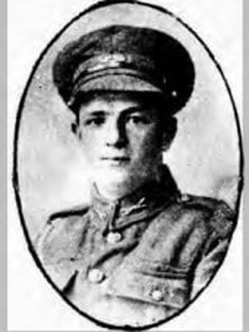
51529 Private
Cyril George Hepher
7th Bn. East Yorkshire Regiment
30th November 1918, aged 21.
Plot XII. A. 13.
Son of Charles and Ann Hepher, of Swavesey, Cambs.
Cyril George Hepher
7th Bn. East Yorkshire Regiment
30th November 1918, aged 21.
Plot XII. A. 13.
Son of Charles and Ann Hepher, of Swavesey, Cambs.
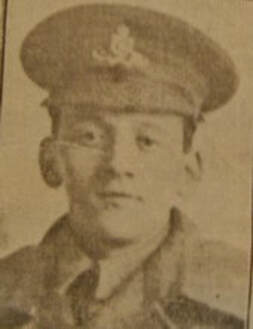
135187 Driver
Luther Hudson
"A" Battery, 11th Bde. Royal Field Artillery
Died of Pneumonia 29th November 1918, aged 25.
Plot XII. A. 4.
Husband of Winifred Hudson, of 821, Manchester Rd., Bradford, Yorks.
Pictures courtesy of Raymond Hudson, grandson of this soldier
Luther Hudson
"A" Battery, 11th Bde. Royal Field Artillery
Died of Pneumonia 29th November 1918, aged 25.
Plot XII. A. 4.
Husband of Winifred Hudson, of 821, Manchester Rd., Bradford, Yorks.
Pictures courtesy of Raymond Hudson, grandson of this soldier




